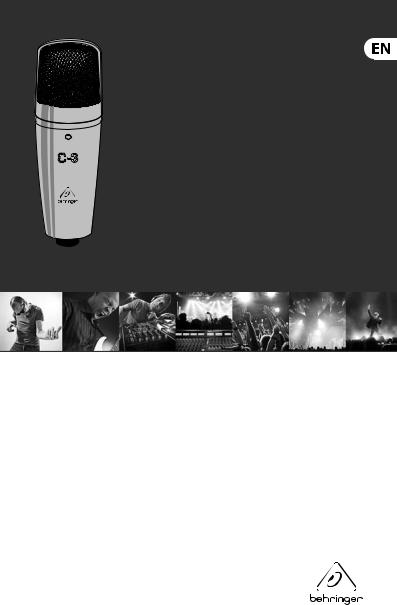Behringer C-3 User Manual

User Manual
STUDIO CONDENSER MICROPHONE 

Dual-Diaphragm Studio Condenser Microphone

2 STUDIO CONDENSER MICROPHONE C-3 User Manual
Important Safety
Instructions
Terminals marked with this symbol carry electrical current of sufficient magnitude to constitute risk
of electric shock. Use only high-quality commercially-available speaker cables with ¼" TS plugs pre-installed. All other installation or modification should be performed only by qualified personnel.
This symbol, wherever it appears, alerts you to the presence of uninsulated dangerous voltage
inside the enclosure - voltage that may be sufficient to constitute a risk of shock.
This symbol, wherever it appears, alerts you to important operating and maintenance instructions in the
accompanying literature. Please read the manual.
Condenser microphones are extremely moisture-sensitive. Never use your microphone in close
proximity to water (e.g. bath tubs, wash basins, sinks, washing machines, pools, etc.).
When doing voice recordings, always use the enclosed windscreen to protect the capsule from moisture.
Always use the power supply specified in the operating instructions.
Take care not to drop
your microphone as this can lead to severe damage.
BEHRINGER assumes no liability for any damage caused by the user.
After each use, wipe the microphone down with a soft cloth and place it back into its
protective casing (included with the microphone). Then, lay the small bag containing the moisture-absorbing crystals on top of the microphone head.
LIMITED WARRANTY
For the applicable warranty terms and conditions and additional information regarding MUSIC Group’s Limited Warranty, please see complete details online at www.music-group.com/warranty.
LEGAL DISCLAIMER
TECHNICAL SPECIFICATIONS AND APPEARANCES ARE SUBJECT TO CHANGE WITHOUT NOTICE AND ACCURACY IS NOT GUARANTEED. BEHRINGER, KLARK TEKNIK, MIDAS, BUGERA, AND TURBOSOUND ARE PART OF THE MUSIC GROUP (MUSIC-GROUP.COM). ALL TRADEMARKS ARE THE PROPERTY OF THEIR RESPECTIVE OWNERS. MUSIC GROUP ACCEPTS NO LIABILITY FOR
ANY LOSS WHICH MAY BE SUFFERED BY ANY PERSON WHO RELIES EITHER WHOLLY OR IN PART UPON ANY DESCRIPTION, PHOTOGRAPH OR STATEMENT CONTAINED HEREIN. COLORS AND SPECIFICATIONS MAY VARY FROM ACTUAL PRODUCT. MUSIC GROUP PRODUCTS ARE SOLD THROUGH AUTHORIZED FULLFILLERS AND RESELLERS ONLY. FULLFILLERS AND RESELLERS ARE NOT AGENTS OF MUSIC GROUP AND HAVE ABSOLUTELY NO AUTHORITY TO BIND MUSIC GROUP BY ANY EXPRESS OR IMPLIED UNDERTAKING OR REPRESENTATION. THIS MANUAL IS COPYRIGHTED. NO PART
OF THIS MANUAL MAY BE REPRODUCED OR TRANSMITTED IN ANY FORM OR BY ANY MEANS, ELECTRONIC OR MECHANICAL, INCLUDING PHOTOCOPYING AND RECORDING OF ANY KIND, FOR ANY PURPOSE, WITHOUT THE EXPRESS WRITTEN PERMISSION OF MUSIC GROUP IP LTD.
ALL RIGHTS RESERVED.
© 2013 MUSIC Group IP Ltd.
Trident Chambers, Wickhams Cay, P.O. Box 146, Road Town, Tortola, British Virgin Islands

3 STUDIO CONDENSER MICROPHONE C-3 User Manual
1. Power Supply
Your condenser mic C-3 needs a phantom power supply (+48 V). If your C-3 is connected to a microphone preamp and supplied with phantom power, the LED on the microphone lights up. BEHRINGER assumes no liability for any damage caused by a defective phantom power supply. Always mute the sound reinforcement system before you switch on the phantom power supply.
2. Directivity
Your C-3 is a large-diaphragm microphone featuring a double membrane. This allows you to choose between three different pickup patterns - cardioid, omnidirectional and
figure eight. Make your selection using the switch located at the back of your microphone.
2.1 Cardioid
Microphones with this polar pattern (switch position: middle,  ) are most sensitive to sound coming from in front of the microphone, and also to a lesser extent from the sides. Sound coming from behind the microphone will be greatly attenuated. This makes the cardioid polar pattern most suitable for recording individual instruments or vocals within a group.
) are most sensitive to sound coming from in front of the microphone, and also to a lesser extent from the sides. Sound coming from behind the microphone will be greatly attenuated. This makes the cardioid polar pattern most suitable for recording individual instruments or vocals within a group.
2.2 Figure eight
Microphones featuring the figure eight polar pattern (switch position: left,  )
)
are most sensitive to sound coming from either directly in front of or directly behind the microphone. Sound coming from either side or above/below is greatly attenuated. This polar pattern is perfectly suited as a reporter mic for two speakers. This pattern can also allow you to create a natural reverb or delay effect. This is achieved by placing the microphone between the sound source and a wall.
The direct sound reaches the “front” membrane first, the reflected sound reaches the “rear” membrane a short time later. You can adjust the delay/reverb time by changing the distance from the mic to the wall.
2.3 Omnidirectional
If you use the C-3 with the omnidirectional polar pattern selected (switch position: right,  ), the microphone is equally susceptible to sound coming from all directions. This polar characteristic is particularly well suited to sessions in which a natural sounding recording is sought, or when several sound sources surround the C-3.
), the microphone is equally susceptible to sound coming from all directions. This polar characteristic is particularly well suited to sessions in which a natural sounding recording is sought, or when several sound sources surround the C-3.
